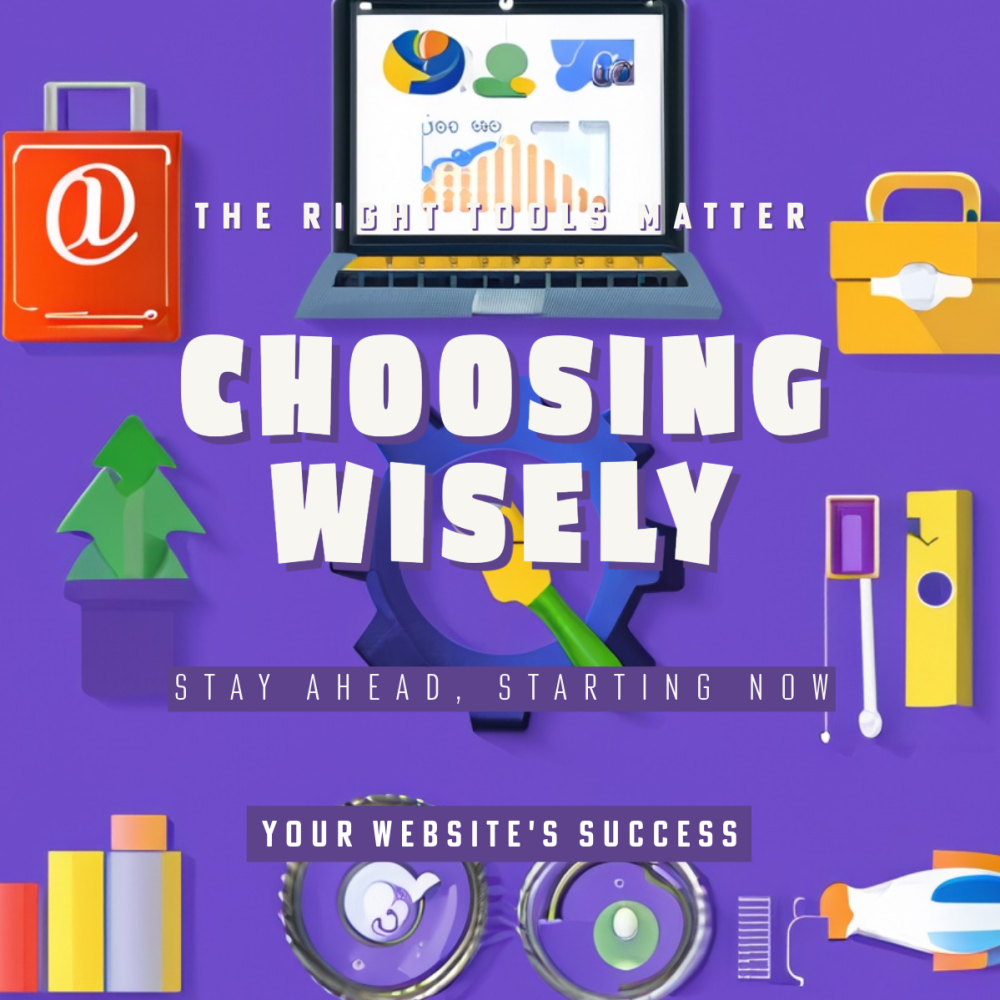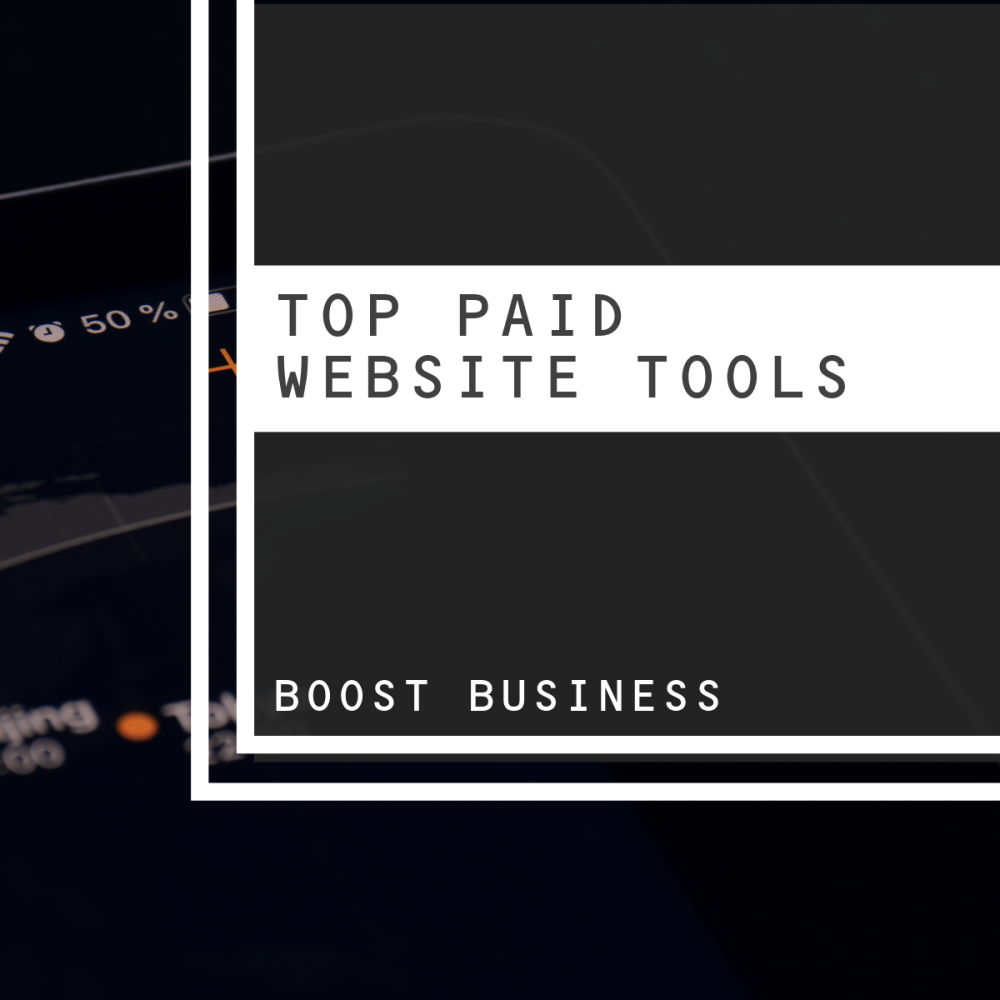Introduction: The Importance of Choosing the Right Tools for Your Business Website

Building a business website is a vital step in establishing a strong online presence and reaching a wider audience. The first and foremost consideration in this process is selecting the right tools, as the choice of tools can significantly impact the website’s functionality, appearance, and overall success. A well-designed website serves as the digital face of your business, providing potential customers with their first impression of what your business stands for and offers. It’s crucial to understand that the quality of this impression can directly influence customer engagement and conversion rates. Thus, investing in appropriate web tools is an investment in your business’s future.
When considering tools, business owners face the decision between utilizing free versus paid options. Free tools, such as basic website builders and open-source content management systems, can be appealing, especially for startups with limited budgets. While these free tools allow you to create a functional website, they often come with limitations in terms of customization, scalability, and support. On the other hand, paid tools generally offer more robust features, enhanced design capabilities, and better overall performance, which can contribute to a more professional and user-friendly website experience. It’s important to weigh these options carefully, considering your business’s needs, goals, and financial resources.
Setting up the right foundation for your website involves more than choosing between free or paid tools; it’s about aligning your website’s functionality with your business objectives. This involves selecting an appropriate domain name that reflects your brand, choosing reliable hosting providers to ensure website uptime and speed, and integrating essential tools such as content management systems, security features, and analytics. By establishing a strong and thoughtful foundation, you create a website that not only looks appealing but also performs efficiently and optimizes user experience. This foundation is key to maintaining a compelling online presence that can adapt to future growth and technological advancements.
Top Free Tools for Building Your Business Website

When you’re ready to start building your business website, having access to the right free tools can make the process more manageable and cost-effective. A variety of options are available, each offering unique benefits depending on your specific needs and technical expertise.
For website builders, popular options include WordPress, Wix, and Weebly. WordPress is a highly flexible and widely-used platform known for its powerful content management system and extensive library of plugins and themes. It’s particularly favored by those looking to create customizable and scalable websites. Wix, meanwhile, provides an intuitive drag-and-drop interface, making it an excellent choice for beginners who want to craft beautiful sites without needing to know how to code. Weebly also offers a user-friendly design experience and e-commerce capabilities, making it suitable for small businesses looking to sell products online.
Optimizing your site for search engines is crucial, and free SEO tools like Google Analytics, Yoast SEO, and Ubersuggest can help you achieve that. Google Analytics is a powerful tool for tracking website traffic and understanding user behavior, allowing you to make data-driven decisions. Yoast SEO is a WordPress plugin that helps optimize your website’s content for better search engine rankings by suggesting improvements and providing readability scores. Ubersuggest, developed by Neil Patel, offers keyword suggestions and insights into your competitors’ SEO strategies, helping you to improve your visibility in search results.
To ensure your website is visually appealing, consider free graphic design tools like Canva, GIMP, and Unsplash. Canva is a versatile online platform for creating professional graphics, with an array of templates suitable for all your design needs. GIMP (GNU Image Manipulation Program) is a free, open-source photo editing software that provides many features similar to Adobe Photoshop, making it ideal for more complex graphic design tasks. Unsplash, on the other hand, offers a vast library of high-resolution, royalty-free images that you can use to enhance your website’s visual appeal without the worry of copyright issues.
Lastly, maintaining effective communication is essential for managing your website and collaborating with your team or clients. Free tools like Slack, Zoom, and Google Workspace can support your communication needs. Slack is a popular messaging platform that facilitates team collaboration with channels, direct messaging, and file sharing. Zoom is well-known for its video conferencing capabilities, making it a great choice for virtual meetings and presentations. Google Workspace offers a suite of productivity tools, including Gmail, Google Drive, and Google Docs, which enable seamless collaboration and information sharing across your team.
In addition to the well-known free tools for building your business website, Wealthy Affiliate offers a unique platform that allows you to learn and develop web skills on a more advanced scale before considering paid options. Wealthy Affiliate’s free version includes a comprehensive range of resources designed to empower entrepreneurs to not only build websites but also understand digital marketing strategies.
Wealthy Affiliate provides free training modules that delve into topics such as niche selection, keyword research, and content creation, allowing you to gain a deeper understanding of how to effectively build and manage an online presence. The hands-on learning environment, coupled with supportive community forums, enables users to ask questions, exchange knowledge, and support each other in real-time, enriching the learning experience.
Moreover, Wealthy Affiliate’s free membership includes access to its proprietary website builder, SiteRubix, where users can build up to two websites for free. This tool is integrated with WordPress, which allows you to familiarize yourself with one of the most popular content management systems while also taking advantage of Wealthy Affiliate’s hosting services.
One of the primary benefits of starting with Wealthy Affiliate’s free version is the opportunity it provides to evaluate your needs and progress without financial commitment. This learning phase can help you build a solid foundation of web development and digital marketing knowledge, boosting your confidence and skills. Once you feel more comfortable and see the potential for your online endeavors, you can explore Wealthy Affiliate’s premium features, which offer more advanced training, additional tools, and a broader range of customizable options to further enhance your website’s performance and success.
Incorporating Wealthy Affiliate’s free tools into your strategy can complement other free web-building tools like WordPress, Wix, and Weebly, while also enriching your SEO strategies with insights from Google Analytics and Ubersuggest. This well-rounded approach equips you with a comprehensive skill set tailored to the digital landscape, ensuring you are well-prepared when considering any investment in paid services or tools.
Top Paid Tools for Enhancing Your Business Website

When you are ready to take your business website to the next level, upgrading to premium tools can provide advanced features and capabilities that enhance your online presence, performance, and productivity. Let’s explore some top paid tools across different categories and see how Wealthy Affiliate can be a great starting platform before investing in these advanced tools.
Website Builders: For those seeking more sophisticated and professional web building options, platforms like Squarespace, Shopify, and Webflow offer robust features tailored to different business needs. Squarespace is known for its sleek, designer-quality templates and all-in-one service, making it a favorite for creatives looking to build visually stunning sites. Shopify is the go-to option for e-commerce businesses, equipped with powerful tools to manage products, payments, and shipping. Webflow provides greater flexibility and control over design, catering to users who require advanced customization without writing code.
By starting with Wealthy Affiliate, you gain foundational web building skills through its intuitive platform. Once you’re ready to expand your capabilities, transitioning to these paid builders becomes much smoother as you’ll have a clear understanding of your requirements and goals.
SEO Tools: Advanced SEO tools like SEMrush, Ahrefs, and Moz offer comprehensive insight into keyword strategies, competitor analysis, and site audits. These tools provide invaluable data that can significantly enhance your SEO efforts, driving more organic traffic to your site.
Wealthy Affiliate’s initial training includes SEO basics, which allows users to understand and implement effective strategies using its free resources. This education can make adopting premium SEO tools more effective, as users can contextualize their advanced features within a well-rounded SEO understanding developed through Wealthy Affiliate.
Graphic Design Tools: As your website grows, leveraging advanced graphic design tools can enhance its visual appeal. Adobe Creative Cloud offers a suite of industry-standard design applications like Photoshop and Illustrator. Sketch is a popular tool among UI/UX designers, and Figma provides seamless collaboration for design teams working together from different locations.
Starting with more straightforward tools like Canva through Wealthy Affiliate enables you to grasp essential design principles. This groundwork prepares you to fully utilize the powerful features offered by these premium graphic design tools when you are ready to upgrade.
Communication Tools: Effective project management and communication become more critical as your business scales. Microsoft 365 offers comprehensive productivity tools along with robust communication capabilities. Asana and Trello are designed to streamline project workflows, ensuring that teams stay organized and on task.
Wealthy Affiliate fosters community learning and interaction from the outset, introducing you to fundamental collaboration. This focus on community and engagement through its platform prepares you to maximize the potential of comprehensive communication suites like Microsoft 365 and project management tools like Asana and Trello.
In summary, Wealthy Affiliate is an excellent starting point for building your business website due to its comprehensive learning resources, community support, and practical tools—all available in its free version. By mastering the basics with Wealthy Affiliate, you equip yourself with the knowledge and confidence to effectively transition to and capitalize on the enhanced capabilities offered by these top-tier paid tools.
How to Decide Between Free and Paid Tools: Factors to Consider

When deciding between free and paid tools for enhancing your business website, it’s important to carefully evaluate several key factors to ensure the best fit for your needs.
Understanding Your Business Needs and Goals: Start by clearly defining what your website needs to achieve. Are you focusing on building an informational blog, creating a portfolio site, or running a complex e-commerce store? Each of these objectives may require different toolsets. Wealthy Affiliate’s free offerings provide a grounding in diverse areas such as content management and SEO, helping you identify what you truly need as you progress towards more advanced functionalities that paid tools offer.
Budget Considerations and Cost-Benefit Analysis: Assess your budget and determine what you are willing to invest in premium tools. Perform a cost-benefit analysis to see if the features provided by paid options justify their price relative to the enhancements or efficiency they bring to your business. Wealthy Affiliate’s free version is invaluable for minimizing initial costs while gaining critical insights and skills, allowing for a more informed investment in paid tools down the line.
Scalability and Future Growth: Consider future growth plans for your business. Choose tools that not only meet your current needs but can also scale alongside your business. Does the tool offer advanced features you might need as you expand, or does it integrate well with other applications? Wealthy Affiliate prepares you for this consideration by offering a solid foundation and understanding of scaling online businesses while strategically planning for the future.
User Experience and Support Options: Evaluate the user experience of the tools—are they easy to use, and do they fit with your technical skill level? Moreover, investigate the support options available. Having access to reliable customer service and resourceful user communities can be crucial in resolving issues quickly. Wealthy Affiliate’s platform is designed to be user-friendly with a strong community of support, ensuring you’re not alone as you navigate through the initial stages of building your business online.
With these factors in mind, you can make a more informed decision about whether to stick with free tools or invest in paid options to achieve optimal results for your business website. Wealthy Affiliate plays a pivotal role in this decision-making process by equipping you with the necessary skills and foundational knowledge.
We invite you to share your thoughts or ask any questions you might have in the comments section below. Whether you’re just getting started or contemplating new horizons for your online business, your feedback and inquiries are incredibly valuable as you join a community of learners and entrepreneurs. We’re here to help guide you through your journey!
Success Stories: Businesses Thriving with the Right Tools

Success Stories: Businesses Thriving with the Right Tools
Real-world examples can be incredibly motivating, as they provide insights into how others have navigated the journey of building their businesses online. Let’s explore some success stories of businesses that have thrived by leveraging both free and paid tools effectively.
Case Studies of Businesses Using Free Tools Effectively: Many startups have successfully launched and grown their businesses by harnessing the power of free tools. For instance, bloggers and content creators often start with platforms like WordPress.com, which allows them to build their online presence without any upfront investment. They use free plugins to enhance their websites and engage with their audience through social media, driving organic traffic without incurring additional costs.
One inspiring example is a small food blog that began with basic free website features and social media promotion. By focusing on creating quality content and engaging with their audience, the blog grew substantially, eventually transitioning to a paid WordPress plan for additional features that perfectly aligned with their expanding needs.
Examples of Businesses That Benefited from Paid Tools: Conversely, many businesses have witnessed significant growth and efficiency gains after investing in paid tools. E-commerce businesses, for instance, often depend on premium platforms like Shopify, which provides comprehensive e-commerce features, secure payment gateways, and customer support that free tools simply can’t match. One notable success story involves a clothing brand that adopted Shopify to streamline its operations. By utilizing the advanced inventory management and marketing tools available in the paid plan, they were able to scale up their sales exponentially, leading to increased revenue and brand visibility.
Another example includes digital marketing agencies leveraging premium SEO tools like SEMrush or Ahrefs. A marketing agency that made the transition saw immediate benefits when it could perform in-depth keyword analysis and competitor research, significantly boosting the performance of their clients’ websites and campaigns.
Lessons Learned and Best Practices: From these success stories, several lessons can be gleaned about the importance of selecting the right tools at the right time. The key takeaways include:
1. Start with What You Have: Begin with free tools to grasp your business’s foundational needs, allowing you to build confidence and competence without financial strain.
2. Pay Attention to Growth Potential: As your business grows, regularly evaluate which tools are helping you achieve your goals and consider investing in premium options that offer scalability and advanced features.
3. Focus on Quality Over Quantity: Choose tools that align with your core business objectives rather than overwhelming yourself with an array of tools that may not add significant value.
4. Continuous Learning: Stay informed about the latest tools and strategies by engaging with communities, such as those at Wealthy Affiliate, where you can learn from others’ experiences and share your insights.
Wealthy Affiliate is an excellent resource for gathering insights and examples of how various tools can be utilized effectively. If you’re interested in how Wealthy Affiliate can help you on your own journey, be sure to take a moment to view my Wealthy Affiliate review linked below. This review shares my personal experience and highlights how the platform can serve as a solid foundation for building and scaling your business website.
As always, I encourage you to comment below with any questions or thoughts you may have! Whether you’re curious about specific tools, seeking advice on getting started, or looking for more success stories, I’m here to help you on this exciting journey. Your engagement can spark valuable conversations that benefit everyone in the community!
Conclusion: Making the Best Choice for Your Business Website

Conclusion: Making the Best Choice for Your Business Website
As we wrap up our discussion on choosing between free and paid tools for your business website, let’s recap the key points that can guide you in making an informed decision.
1. Understanding Your Business Needs: It’s crucial to clearly define your goals and objectives before selecting tools. Whether you aim to create a simple blog or an extensive e-commerce platform, knowing your needs will shape your choices.
2. Budget Considerations: Assess your financial situation and conduct a cost-benefit analysis to ensure that any investment—be it in free or paid tools—aligns with your budget and expected returns.
3. Scalability: Consider how your choices will affect your future growth. Ensuring that the tools you select can evolve alongside your business is vital to long-term success.
4. User Experience and Support: Choose platforms that are user-friendly and provide robust customer support. A supportive community can make a significant difference, especially for those new to the digital space.
With these points in mind, remember that starting small is often the best approach. Engage with free tools initially to build your skills and understand your business’s unique requirements. As you grow more confident and your needs become more complex, you can transition to paid tools that provide the added functionality you desire.
In closing, finding the right balance between cost and functionality is key to sustaining your business approach. While free tools can offer a great starting point, paid options can deliver capabilities that can significantly enhance your operations and help you achieve your goals. The right choice ultimately comes down to your individual situation and vision for your business.
I encourage you to take action and begin evaluating the tools available to you. Trust in the process, adapt as you learn, and don’t hesitate to start small. Your online journey is just beginning, and with thoughtful consideration, you will be well-equipped to thrive.
If you have any questions or want to share your experiences, please comment below. I’m here to support you, and your insights can help others as well! Together, we can navigate the journey of creating a successful business website.
